#traditional Hawaiian chant
Explore tagged Tumblr posts
Text
Noelani Love // "E Hō Mai" (Traditional Hawaiian Mele / Oli Chant)
E hō mai ka ‘ike mai luna mai e (Grant us the wisdom from above,)
I nā mea huna no‘eau o na mele e (The hidden secrets of the songs;)
E hō mai – e hō mai – e hō mai (Grant it to us, give it to us, give it to us.)
E hō mai ka ‘ike mai luna mai e (Grant us the wisdom from above,)
I nā mea huna no‘eau o na mele e (The hidden secrets of the songs;)
E hō mai – e hō mai – e hō mai (Grant it to us, give it to us, give it to us.)
#e hō mai#mele#oli#Hawaiian mele#Hawaiian oli#'ōlelo Hawai'i#Noelani Love#Hawaiian chant#traditional Hawaiian chant#Hawaiian music#Hawaiian culture#wisdom#secrets#grant us#ancestors#Spotify
0 notes
Text

nice fuckin save tumblr. rename the racist appropriative crab designed by a white guy after you get backlash from your userbase but dont redesign it or take it down from your store. real smooth!!


Island Crab Keychain • $5.00
Bring a little bit of the island into your life with this Island Crab Keychain.
1.46″ x 1.53″
Printed in full color on one side (the back is white).
Clear snap closure and stainless steel key ring.
About the Artist
This design was created by Justin Carlson. When not helping us make fun products for the tumblr shop you can find him do collaborative drawing projects on Instagram.
#people in the notes said it better than me#but the 'hula girl' aesthetic is so fucking anti-native and appropriative. the hula is part of hawaiian culture and isnt a costume#ESPECIALLY with the fucking coconut bra ?#did you know that the 'grass skirts' as well as the grass bracelets in traditional hula are considered sacred#did you know that even the slightest mistake or misstep in a hula performance is seen as bad luck and a sign of disrespect?#did you know that hula is a method of storytelling to accompany a chant; with specific movements that correspond to different subjects?#even after the censorship of hula by xtian missionaries the tradition lives on thru the efforts of hawaiian royalty to retain their culture
2K notes
·
View notes
Text
Mary Kawena Pukui
Mary Kawena Pukui was born in 1895 in Kaʻū, Hawaii. Pukui was a scholar who devoted herself to preserving traditional Hawaiian culture. She produced thousands of pages of translations and wrote or contributed to over 50 scholarly works. Pukui co-wrote The Hawaiian Dictionary with Samuel H. Elbert, and the 1986 edition of the book is still the standard source for spelling and definitions in the Hawaiian language. She collected and translated nearly 3,000 Hawaiian proverbs and sayings in the book Ōlelo Noʻeau. Pukui was also a hula expert and composed more than 150 songs and chants.
Mary Kawena Pukui died in 1986 at the age of 91.
#hawaii#hawai'i#indigenous culture#indigenous women#hawaiian#history#hawaiian history#hawaiian culture#native hawaiian
11 notes
·
View notes
Note
do u have any favourite hawaiian songs/musical artists? :D i'd love to have some more music to explore, but i don't know where to find
I don't actually listen to much non-English music, so I don't have many Hawaiian songs to recommend, but I feel like one of the most popular and widely known Hawaiian songs would be Queen Lili'uokalani's Aloha 'Oe. Here's a downloadable album of some of the pieces she wrote along with a short article about her music. The recording I linked for Aloha 'Oe includes Bruddah Iz, arguably the most famous modern Hawaiian musician!
One song I like that's not necessarily completely traditional, but is almost entirely derived from the traditional chant "Mele Inoa no Kalakaua" (Name Song for Kalakaua), is "He Mele No Lilo" from the Lilo & Stitch movie. Both of these are interpretations of traditional lyrics by Mark Keali'i Ho'omalu, so I definitely recommend checking some of his music out if you're interested in Hawaiian-language music!
#hawaiian#hawaiian language#olelo hawaii#ʻōlelo hawaiʻi#language#music#langblr#hawaiian music#polynesian languages
4 notes
·
View notes
Text
This is something that's been tugging at my heartstrings for as long as I can remember.
I'd be lying if I said I've never quite felt as the gender that was assigned to me at birth. Because I did. I was born a cisgender male and it felt right. Or, at the very least, it felt partially right. Like it was always just one half of what or who I really am.
I would adamantly try to deny these strange feelings I'd get while coming across terms such as "non-binary" or "intersex".
Because we've always been taught that there only exist two sexes: male and female.
Transgender people are viewed as "strange" or "diseased" by most cishet folk because of their simple inability to comprehend those who are different from them.
However, they are, at the very least, becoming more and more visible in both media coverage and the regular everyday life. And their existence had become much more digestible to the general mainstream culture under the oversimplified explanation how transgender people are just "people who feel like, and desire to be, the opposite gender".
Then what can someone tell me about those of us who've always felt like multiple genders at once.
As previously mentioned...
I was born and raised a male but always felt like the other half of me is missing. Like this gender identity I possess is only half of the entire truth.
Because I've always felt like I was meant to be both a man and a woman at the same time. And this is not just when speaking about my identity, but body and mind as well.
Even my genital always felt incomplete without the lady bits.
And that's when I learned of the old Greek legend of a "Hermaphrodite", or "Hermaphroditus".
Now, for those of you who are not familiar with this term, let me explain...
There are multiple versions of this ancient myth, but they all share one major important aspect in common.
Hermaphroditus was the bastard child of Aphrodite, goddess of love, and the messenger god - Hermes.
"It" was described as a two-sexed being of both male and female likeness and was considered an important symbol in fertility and marriage unions, as it symbolized both "power of a man" and "beauty and compassion of a woman".
But, as it turns out, Ancient Greek people were not the only nation known for such a tale.
Majority of the Hinduistic pantheon are gods and goddesses described as at least partially androgynous.

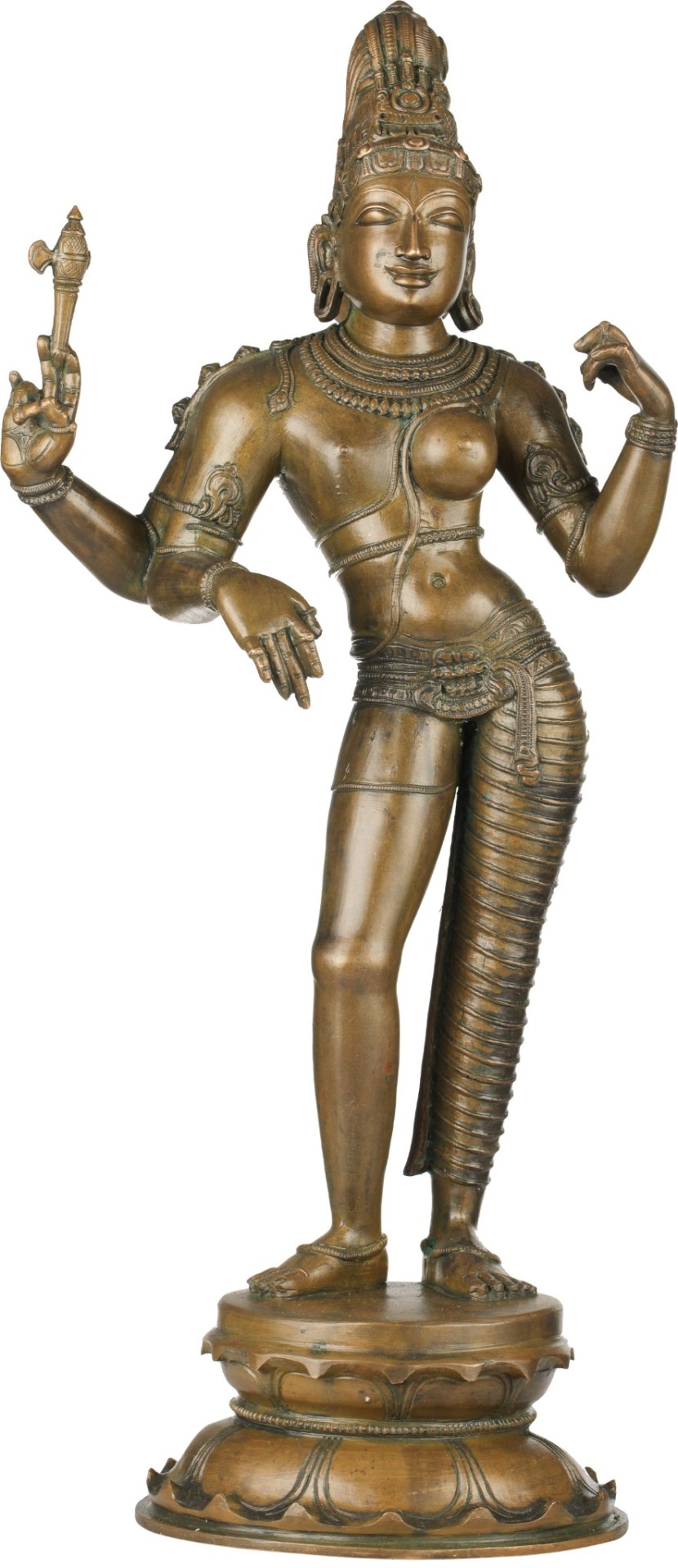
Come forth, Ardhanarishvara
The one whose name would literally translate "Half-Female Lord" from Sanskrit.
The form taken by the very supreme god Shiva when merging with his consort goddess, Parvati.
Ardhanarishvara represents the synthesis of masculine and feminine energies of the universe (Purusha and Prakriti) and illustrates how Shakti, the female principle of God, is inseparable from (or the same as, according to some interpretations) Shiva, the male principle of God, and vice versa. The union of these principles is exalted as the root and womb of all creation. Another view is that Ardhanarishvara is a symbol of Shiva's all-pervasive nature. And that's not even mentioning traditional Hindu notion of the "third gender" people known as hijras.
Or who can forget the gender nonconforming individuals of ancient Hawaiian and certain Native American tribes. "Two-Spirit" individuals, as they are called today.
These men and women behaved in a manner befitting both sexes and we're often permitted or even downright encouraged to participate in roles attributed to the opposite sex.
Mahū, as they were called in Hawaii, were "third gender" people with traditionally spiritual and religious roles in their society. Historically, it's been used primarily for those born male, but it's meaning had evolved since then and has come to refer to multitude of genders and sexual orientations in modern Hawaii.
Māhū were particularly respected as teachers, usually of hula dance and chant. In pre-contact times māhū performed the roles of goddesses in hula dances that took place in temples which were off-limits to women. Māhū were also valued as the keepers of cultural traditions, such as the passing down of genealogies. Traditionally parents would ask māhū to name their children.
The term itself may be used either pejoratively or respectfully when referring to modern LGBTQI+ people of Hawaii.
But yes
All these traditions and mythologies aside,
Hermaphroditism and Intersexuality had always been so very intriguing and inviting for me. Imagine my surprise to learn that over half of the plant world is hermaphroditic and in possession of both male and female reproductive parts. The same thing applies to creatures such as snails, slugs, leeches,etc. Not to mention a pseudo-hermaphroditism that occurs in female hyenas and cassowaries evolving pseudo-penises.
Or the very people who are born Intersex and thus possess characteristic of both sexes.
Gender dysphoria has been something I've come to consider a lot. Especially as of late. And I cannot deny that I've always felt amused when somebody happens to misgender me online.
Once I had been referred to as "ma'am" by an online friend of mine when rp-ing as a genderless character from an old video game.
I was intrigued not because I found it funny but rather endearing. Something deep inside told me that calling myself ma'am feels just as right as being announced as sir.
I've always felt as intersex in a way. At least in my subconscious.
I've always identified as pan or bi and felt attracted to both men and women (especially to dominant, muscular ones but that is a story for another day). But I was always particularly fond of gay shippings and stories. And it's very fun to see many best fanfics blur the line between "passive/feminine" partner and an "active/dominant" one. Only further emphasizing the duality within human being.
But, of course, my yearning to explore more themes of gender nonconformity and "Intersexuality" do not stop there.
Intersex People sorely lack in representation and it is never unwelcomed to behold a cool fictional character falling under that category.
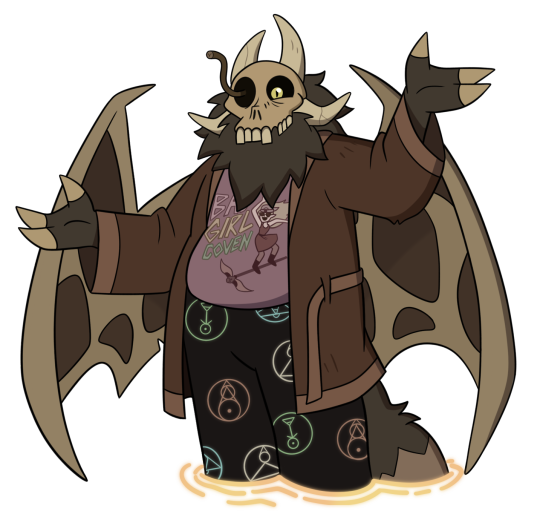
Seeing The Titan from The Owl House present themselves as bigender being was beyond awesome.
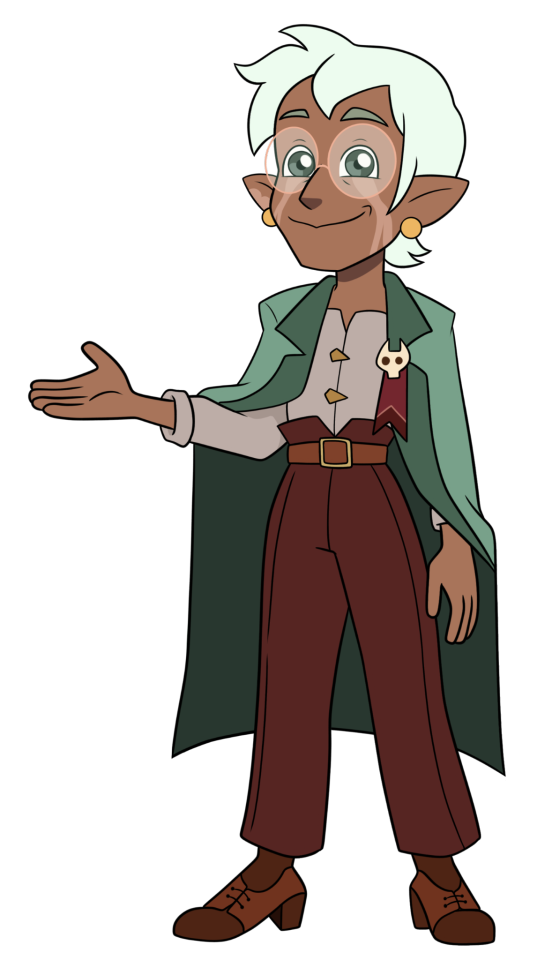
Not to mention that, while I don't know if they can be counted as such, Raine Whispers perfectly captures an androgynous non-gender specified appearance.
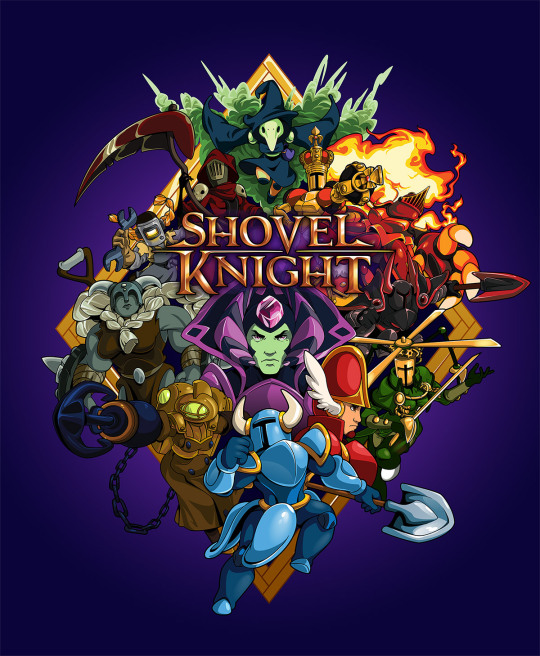
Or the amazing Body Swap mode that Shovel Knight offers to it's players. In which you are not only able to genderswap any important member of the original cast (and thus create semi-canon queer romances 😉), but also put your titular protagonist into a female body while giving then gender neutral or even masculine pronouns.
And how a very similar thing is included in the critically acclaimed masterpiece that is Elden Ring.
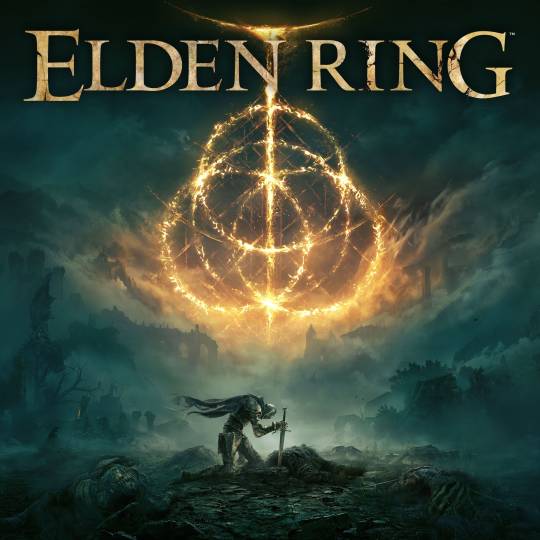
In which you are not just able to change your character's gender and body type at will, but also experiment with them. Putting a female head on a male protagonist (and vice versa) is a memorable and progressive feature for sure.
Sadly, however
Such portrayals aren't always in positive light.
One of my all time fav 3D Platformer franchises, Ty The Tasmanian Tiger, does include a villainous eldritch race of hermaphroditic shape-shifting extraterrestrials known as "Quinkans". Who serve as the main antagonists of the 3rd installment.
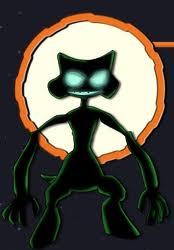
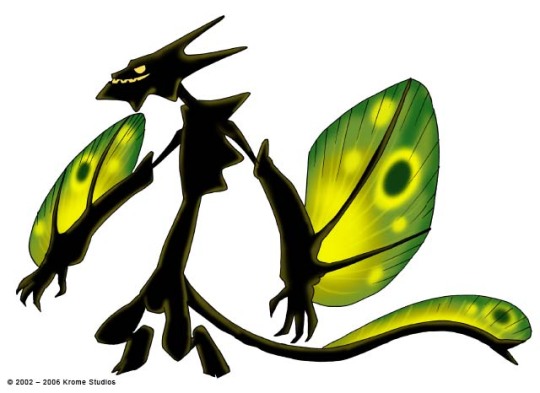
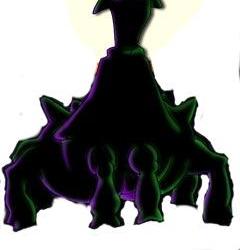
This also applies to old myths.
Take the old Romani mythology that includes a horrific self-fertilizing Poreskoro
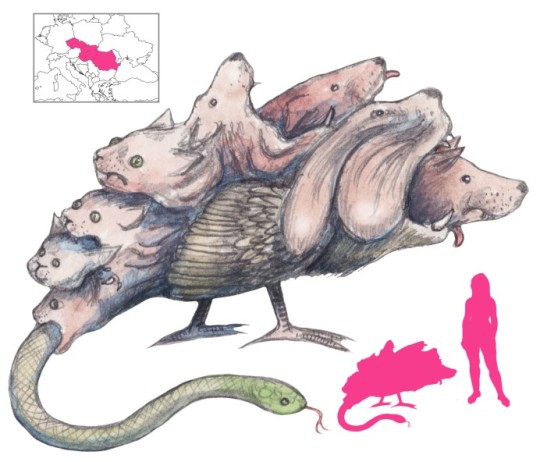
The progenitor of many illnesses that wreak havoc upon humanity to this very day.
But as with everything else. Bad ones should be separated from the good portrayals and not be taken as the root of all beliefs, thus giving rise to prejudices and negative assumptions.
And for the sake of not making this post hours long, I shall just end it by announcing my support for all the other people who feel similarly about themselves. And to say that it feels so very liberating to be true to one's self.
Yes I AM a guy. But I am also equally a woman. Not neither. But both. And I am so very glad to be a part of this wonderful social media where differences between people are highly celebrated and explored.
And I want to thank anyone who took time and energy to read through this little article of mine. Hope it wasn't too long or tedious to read.
And with that, I wish you all a wonderful day 💐💖
#confession#lgbtqia#self reflection#intersex#gay#gender dysphoria#self discovery#nonbinary#the owl house#fictional examples#queer representation#hindu mythology#mythology and folklore#greek mythology#third-gender#hermaphrodite#two spirit#bisexual#pansexual#gender
4 notes
·
View notes
Text
The Origins and Evolution of Hula Dance
The origins and evolution of Hula Dance Hawaii are deeply intertwined with the history, spirituality, and cultural expression of the Hawaiian people. Hula is much more than just a dance; it's a living narrative that weaves together the stories, traditions, and values of Hawaii. Let's explore the journey of hula from its ancient roots to its modern-day expressions.
Ancient Origins
Hula originated in the Hawaiian Islands, with its origins shrouded in mythology and oral histories. According to one Hawaiian legend, the goddess Hiʻiaka, sister to the volcano goddess Pele, is credited with creating the first dance to appease her sister. Another legend credits Laka, the goddess of hula, with its creation. Regardless of its divine origins, hula was initially a form of worship performed in heiau (temples) or before altars dedicated to Hawaiian gods.
Early Hula
In ancient times, hula served multiple purposes: it was a way to honor gods, to record and convey history and genealogy, and to celebrate nature, fertility, and warfare. The dance was accompanied by oli (chants) and mele (songs), with dancers adorned in symbolic attire made from natural materials like leaves, feathers, and bark. This form of hula, known as Hula Kahiko, is characterized by its rigorous discipline and spiritual underpinnings.
Contact with the Western World
The arrival of Captain James Cook in 1778 marked the beginning of significant changes for the Hawaiian Islands and for hula. With the influx of missionaries in the 1820s, hula faced severe repression, as it was seen as pagan or immoral by Christian standards. However, King David Kalākaua, known as the "Merrie Monarch," played a crucial role in the revival of hula in the late 19th century, promoting it as a proud component of Hawaiian heritage and encouraging public performances.
Hula ʻAuana: The Evolution
Hula ʻAuana emerged in the late 19th and early 20th centuries, evolving in response to Western influences and the changing cultural landscape of Hawaii. Unlike Hula Kahiko, Hula ʻAuana incorporates modern musical instruments like the ukulele and guitar and features more fluid, expressive movements. This style of hula is often more accessible to broader audiences, telling stories of love, nature, and daily life in Hawaii.
Modern Hula
Today, hula is a vibrant part of Hawaiian culture, celebrated worldwide. It continues to evolve, embracing both traditional and contemporary influences while maintaining its roots in Hawaiian history and spirituality. Hula schools (hālau hula) and festivals, such as the renowned Merrie Monarch Festival, play a vital role in preserving and perpetuating hula traditions. Through these institutions, generations of Hawaiians and hula enthusiasts from all over the world learn not only the dance but also the Hawaiian language, chants, and cultural values embedded within it.
The Global Influence of Hula
As hula has spread globally, it has also adapted, blending with other dance forms and cultural expressions while retaining its unique identity. This global interest has sparked conversations about cultural appropriation, emphasizing the importance of respecting and understanding hula's deep cultural significance.
The evolution of hula dance from its ancient origins to its modern expressions is a testament to the resilience and adaptability of Hawaiian culture. Hula is not just a dance; it is a celebration of life, a preservation of history, and a bridge connecting past to present and future. Through hula, the stories, traditions, and spirit of Hawaii continue to enchant and enlighten the world.
2 notes
·
View notes
Text

Glistening green peridot is a volcanic gem formed in the deep fires of the earth; on Hawaii, it is treasured as the tears of Pele. An entire beach in Oahu is formed of peridot sand, worn to powder by the ceaseless ocean.
Tempestuous Pele is the goddess of the volcano, with all its power and capriciousness. In ancient Hawaiian chants, she was described as “She-who-shapes-the-sacred-land” and her temper was known to be both as abundant and dangerous as the lava. Traditional tales abound of her love affairs and liaisons, of the rivalry with her sisters and brothers, of the storms and waves with which one after another god tried—and failed—to subdue her.
In Hawaii, it’s impossible to avoid the evidence of her power and generosity. Since 1983, her volcano has destroyed more than 100 structures on the Big Island—while adding more than 70 acres to the island’s southern coastline.
From Maui divers.com
2 notes
·
View notes
Text

[image text: "Her mother Pauahi died during childbirth, and Luka was raised by the Kūhina Nui and wife of Kamehameha I, Ka‘ahumanu. As a high-ranking ali‘i wahine and descendant of Kamehameha I, Luka was educated at the Chiefs’ Children’s School, where she learned, among other things, the English language and tenants of Christianity.
Her high rank meant significant appointments in the government of the Kingdom. Princess Ruth served on the Privy Council and later in 1855 was appointed Governess of Hawai‘i Island. She was a very strong-willed woman and as she witnessed continued attacks on native traditions printed in the newspapers and mission press, she fought back with equally strong statements. Although her mission education meant that she understood English, she staunchly refused to do business in anything other than her Native ‘Ōlelo Hawai‘i. Those who could not speak Hawaiian were required to use an interpreter." /text]

[image text: "On August 9, Princess Ruth approached the lava at the foot of Puu Hālai and made offerings to Pele of chants and prayers, brandy, 30 red silk scarves, and a lock of her own hair – doubly sacred by virtue of being from her head as well as by the fact of her royal lineage.
In Hawaiian culture, the head and hair are sacred. They are the part of you closest to God. In our culture, you never touch someone else’s head or hair. A gift of one’s own hair is a very special gift, indeed.
Ruth’s great grandfather, Paiea Kamehameha, had offered his own hair to Pele and stopped the lava flow at Kaupulehu only 80 years before.
That night the Princess slept at the edge of the flow. By morning Pele’s anger was appeased. The flow had stopped.
Hilo, and Puu Hālai, and the Hilo Jail with it’s strong inmates, were spared." /text]
e ola ❤️🔥
#hey remember how there was a list of things i was supposed to be doing in exchange for help w turbo's cremation#&then i literally lost my mind a little bit&then needed to readjust to several different medications so i def didnt do any of the shit#i said i would do? i remember. i remember all my failures.#but im in the process of getting the piece about ke aliʻi kamehameha together like i said i would like six months ago#&it reminded me of one of my fav figures in hawaiian history: princess keʻelikōlani#another member of the kamehameha lineage&raised by kaʻahumanu something i cannot express the value of.#she is one of my heroes lmao. i think about the story of her&pele all the time.#♡#yas
2 notes
·
View notes
Link
5 notes
·
View notes
Text
I really do understand their misconceptions.
I get it. I have blonde hair and brown eyes. I have a light tan. I have smooth skin. I wear nice pants and fun, light-colored sweaters or button down shirts. Sometimes, if I feel extra silly, I wear Hawaiian shirts. I love swimming, gardening, jogging, and going to the gym. I’m reasonably strong. I look and act like a real life Ken doll.
The kids still don’t always realize that being goth doesn’t automatically make you a witch.
It’s not that Anna and her mom aren’t nice. The neighbors all love Anna. She bakes cookies for the neighborhood kids and has the best decorations at Halloween. Despite not looking particularly traditional, everyone in the neighborhood trusts her to house sit or take care of their kids or pets. They always said Anna has this sort of magical charm.
We’re the best of friends, so that’s partially my doing. I gave her a little spell jar to help her with her confidence and her communication skills. That was all she needed to get everyone in the neighborhood to love her a little bit faster. She just needed to love herself a bit better first.
Since she was the goth girl everyone knew and trusted, of course they assumed that she’d be able to provide supernatural or occult help.
Every time kids or the occasional superstitious neighbor, be it a jilted lover or a person seeking protection, would go knock on her door, she’d be greeted with someone asking for the help of a good witch. She’d try to politely direct them elsewhere. She’d try to send them to me.
They always laughed it off as a joke. She always cringed a little bit harder.
Eventually I took it into my own hands and started selling little spell jars and leaving little blessed trinkets on people’s doorsteps, complete with a name card I made by hand. Those were my spells and incantations, my prayers to my gods, gifts that I left.
The neighbors thought that it was a practical joke. They never took my name as a witch seriously until the day one of the neighborhood kids knocked on my door and asked whether the note was true and the spell and the blessed necklace that helped heal his mama’s fever was really from me.
“Yes,” I said softly. “It’s true. I made that spell and left that blessed trinket and the notes for use specifically for your mama and you.”
“Prove it,” he dared. “Show me some other magic you can do and I’ll believe it.”
“Inquisitive and thorough… you check your sources. That’ll take you far in life. Let me help you with some more evidence.”
I began to murmur chants and prayers, casting glamours and other illusion charms. I turned my eyes purple, then blue, then red. I changed my short blonde hair at will to a shoulder length mop of shaggy black hair and back.
I have never seen someone more amazed than that in my life. He was smiling widely and clearly in awe. Kids love magic tricks, and perhaps to him it was just that.
After showing off my little spells, I turned back inside my house for a minute to grab a special gift from my kitchen. I gave the kid a mason jar. “If you use this jar as a pencil holder, it will help you gain wisdom and knowledge as you get older.”
The kid took the jar and skipped home.
Now his family knocks on my door when they need magical help.
Most of the other neighbors and their families still haven’t caught on, but as long as someone starts the rumor mill in this community, the word will spread fast.
Maybe Anna will catch a break.
You are a young man, fair of complexion and strong of body. Unfortunately this means that people keep bothering the nice goth lady down the street instead of coming to you when seeking the services of a witch
5K notes
·
View notes
Text
Nightmarchers, what are they ?
Nightmarchers Research Post wk 12
Background Information: Nightmarchers, or Huaka‘i pō in Hawaiian, are ghostly figures from Hawaiian folklore. They are believed to be the restless spirits of ancient Hawaiian warriors who march at night to protect sacred sites or escort the souls of the dead to the afterlife. According to legend, Nightmarchers appear in long processions, often accompanied by drums, chanting, and torches, and their path must never be crossed. To disrespect their procession is said to bring misfortune or even death.
Nightmarchers are tied to specific times and places, such as the nights of Kane, Ku, or Lono (Hawaiian gods) and areas with strong spiritual significance like ancient battlefields or burial grounds. Those who encounter them are advised to lie face down, avoid eye contact, and show reverence to avoid harm. In rare cases, a person with ancestral ties to the warriors may be spared or even protected by the procession.
Pop Culture/Media Reference: Nightmarchers have appeared in pop culture, notably in the TV series "Hawaii Five-0", where an episode explores their mythology as part of a supernatural crime investigation. Additionally, in the survival video game "Nightmarchers", the legend comes alive as players navigate a post-apocalyptic Hawaiian setting where these spirits guard sacred land.
Another instance is the 2015 documentary "The Haumana", which explores Hawaiian cultural legends, including Nightmarchers, to preserve their significance in modern Hawaiian identity. These depictions highlight the deep respect for Hawaiian culture while bringing the eerie legend to a wider audience.
Analysis: If Nightmarchers aren’t supernatural, what might they be? One possibility is auditory and visual illusions created by the wind, animals, or other natural phenomena in the dense Hawaiian forests at night. For example, the sound of drums or chanting could be attributed to the acoustics of waves or wind echoing through valleys. Another theory could involve collective memory—when communities pass down stories, shared belief systems might make people more likely to perceive these processions as real.
From a historical perspective, the Nightmarcher legends might serve as cultural reminders of ancient practices and taboos, reinforcing respect for sacred sites and traditions. This symbolic role might explain their enduring significance in Hawaiian culture.
Do I Think It’s Real? While scientific explanations provide plausible alternatives, the reverence surrounding Nightmarchers makes me pause. The consistency of these stories across generations and the fear they evoke suggest there’s more to them than just imagination. Whether a spiritual phenomenon or deeply rooted cultural memory, Nightmarchers represent the profound connection between the Hawaiian people, their land, and their ancestors.
0 notes
Text
How Pohaku Lomilomi Differs from Other Hot Stone Massages
Hot stone massages have long been a staple in the world of relaxation and therapy, offering a unique way to ease muscle tension and promote overall well-being. Among the various forms of hot stone massages, Pohaku Lomilomi stands out with its rich cultural roots and distinctive techniques. In this article, we'll delve into how Pohaku Lomilomi differs from other hot stone massages and explore what makes it a unique and deeply enriching experience.

What is Pohaku Lomilomi?
Pohaku Lomilomi is a traditional Hawaiian massage technique that incorporates the use of heated stones, known as "pohaku," to enhance the massage experience. The term "Lomilomi" translates to "kneading" or "massage" in Hawaiian, reflecting the deep, therapeutic strokes used in this practice. Pohaku
Lomilomi is not just a physical treatment but also a spiritual and cultural journey, deeply connected to Hawaiian traditions and beliefs.
History of Pohaku Lomilomi
The origins of Pohaku Lomilomi can be traced back to ancient Hawaii, where it was practiced by kahunas (Hawaiian shamans or healers) as a form of holistic healing. This massage technique was an integral part of Hawaiian life, used to treat various ailments, promote physical and spiritual well-being, and maintain balance within the community. Over time, Pohaku Lomilomi has evolved, but it still retains its traditional essence and spiritual significance.
Traditional Hot Stone Massages
Before we dive deeper into Pohaku Lomilomi, let's take a quick look at traditional hot stone massages. These massages typically involve placing smooth, heated stones on specific points of the body. The heat from the stones helps to relax muscles, improve blood circulation, and alleviate pain. Commonly used in various cultures, hot stone massages are known for their soothing and therapeutic effects.
Key Differences Between Pohaku Lomilomi and Other Hot Stone Massages
Techniques and Methods
One of the most notable differences between Pohaku Lomilomi and other hot stone massages lies in the techniques and methods used. While traditional hot stone massages may focus primarily on the physical manipulation of muscles, Pohaku Lomilomi integrates rhythmic, flowing movements that mimic the natural flow of the ocean. These movements are not only therapeutic but also meditative, promoting a deep sense of relaxation and connection to nature.
Stones Used in Pohaku Lomilomi
In Pohaku Lomilomi, the stones are carefully selected from Hawaiian beaches and rivers. These stones, often volcanic in origin, are believed to hold the mana (spiritual energy) of the islands. They are meticulously heated and used to perform the massage in a way that harmonizes with the body's energy flow.
Philosophical and Spiritual Aspects
Pohaku Lomilomi is deeply rooted in Hawaiian philosophy and spirituality. It is more than just a physical treatment; it's a holistic healing practice that addresses the mind, body, and spirit. Practitioners often incorporate traditional chants, prayers, and breathing techniques to create a sacred space for healing. This spiritual dimension sets Pohaku Lomilomi apart from other hot stone massages, which may not emphasize this aspect as strongly.
Techniques of Pohaku Lomilomi
The techniques used in Pohaku Lomilomi are unique and tailored to the individual's needs. Practitioners use a combination of long, sweeping strokes, gentle stretching, and rhythmic movements to release tension and promote relaxation. The use of heated stones adds an extra layer of depth to the massage, allowing for deeper muscle penetration and enhanced therapeutic effects.
Stones Used in Pohaku Lomilomi
The stones used in Pohaku Lomilomi are typically smooth, flat, and of volcanic origin. They are chosen for their ability to retain heat and their smooth texture, which glides effortlessly over the skin. Before the massage, the stones are heated to a comfortable temperature and are often blessed with a traditional Hawaiian prayer to imbue them with positive energy.
Philosophy Behind Pohaku Lomilomi
At the heart of Pohaku Lomilomi is the Hawaiian philosophy of "Aloha" and "Mana." Aloha represents love, compassion, and respect, which are integral to the practice. Mana refers to the spiritual energy that flows through all things. The goal of Pohaku Lomilomi is to balance and restore the flow of mana within the body, promoting holistic healing and well-being.
Similar Link: Why Lomi Lomi Massage Suits Pregnant Women the Best
Benefits of Pohaku Lomilomi
Physical Benefits
Pohaku Lomilomi offers numerous physical benefits, including improved circulation, reduced muscle tension, and enhanced flexibility. The heat from the stones helps to soothe sore muscles and joints, making it an effective treatment for chronic pain and stiffness.
Mental and Emotional Benefits
In addition to its physical benefits, Pohaku Lomilomi also has profound mental and emotional effects. The meditative nature of the massage, combined with the calming heat of the stones, helps to reduce stress, anxiety, and emotional blockages. Many clients report feeling a deep sense of peace and relaxation after a session.
Cultural Experience
Experiencing Pohaku Lomilomi is not just about the massage itself but also about immersing oneself in Hawaiian culture. The practice often includes elements such as traditional Hawaiian music, chants, and the use of natural oils and scents from the islands. This cultural immersion adds a unique and enriching dimension to the massage experience.
Practitioners of Pohaku Lomilomi
Practitioners of Pohaku Lomilomi are not just massage therapists; they are often viewed as healers who have undergone extensive training and initiation into the practice. They possess a deep understanding of Hawaiian traditions and the spiritual aspects of the massage. Their role is to facilitate healing on multiple levels, guiding clients on a journey of physical, mental, and spiritual renewal.
Pohaku Lomilomi in Modern Spa Practices
In recent years, Pohaku Lomilomi has gained popularity in spas around the world. Many modern spas have adopted this traditional practice, often incorporating contemporary elements while staying true to its roots. This global spread has made Pohaku Lomilomi more accessible to those seeking a unique and deeply therapeutic massage experience.
Why Choose Pohaku Lomilomi?
Choosing Pohaku Lomilomi means embracing a massage that goes beyond the physical realm. It offers a holistic healing experience that addresses the mind, body, and spirit. Whether you are looking to relieve physical tension, reduce stress, or simply immerse yourself in a unique cultural practice, Pohaku Lomilomi provides an unparalleled journey of wellness and renewal.
Conclusion
Pohaku Lomilomi is a distinctive form of hot stone massage that combines traditional Hawaiian techniques with the therapeutic benefits of heated stones. Its deep cultural roots, unique methods, and holistic approach make it a standout choice for those seeking a truly enriching massage experience. By embracing the philosophy of Aloha and the power of Mana, Pohaku Lomilomi offers a pathway to profound healing and well-being.
0 notes
Text
Lomi Lomi Massage: Hawaiian Healing Tradition
In the heart of the Pacific, amidst the lush landscapes of Hawaii, there exists a massage tradition that goes beyond the physical realm—a practice that embodies the spirit of aloha and the interconnectedness of body, mind, and spirit. Lomi Lomi, often referred to as "Loving Hands" massage, is a sacred and ancient healing art passed down through generations of Hawaiian practitioners. In this exploration, we delve into the rich tapestry of Lomi Lomi massage, uncovering its origins, principles, techniques, and the profound wellness journey it offers to those seeking harmony and balance.
Origins and Cultural Roots of Lomi Lomi:
Lomi Lomi is deeply rooted in the traditions and spirituality of the Hawaiian people. Historically, it was practiced in temples (called heiau) as a sacred ritual that integrated physical and spiritual healing. The Hawaiian concept of "mana," representing spiritual energy, is central to Lomi Lomi, and practitioners aim to channel this energy to restore balance and harmony. 증평출장안마
The art of Lomi Lomi has been preserved through the teachings of kupuna (respected elders) and kahunas (spiritual leaders). These mentors passed down the knowledge and techniques of Lomi Lomi to ensure its continuation as a sacred and culturally significant practice.
Principles of Lomi Lomi:
Aloha Spirit: At the core of Lomi Lomi is the Aloha spirit—a deep sense of love, compassion, and respect. Practitioners infuse their work with this spirit, creating a space of acceptance and connection.
Ohana (Family) Connection: Lomi Lomi is often referred to as "the massage of the family" because it emphasizes the interconnectedness of all living things. The massage is seen as a way to foster a sense of community and harmony.
Flow and Fluidity: Lomi Lomi is characterized by its flowing and rhythmic movements, often likened to the ebb and flow of the ocean waves. This continuous motion is thought to facilitate the release of tension and promote the free flow of energy.
Intuition and Presence: Lomi Lomi practitioners rely on their intuition and a deep sense of presence during sessions. The massage is not formulaic; instead, it evolves in response to the client's needs and the guidance of the practitioner's intuition.증평출장마사지
Lomi Lomi Techniques:
Long, Fluid Strokes: Lomi Lomi is distinguished by its long, continuous strokes that traverse the entire length of the body. These flowing movements contribute to a sense of unity and relaxation.
Use of Forearms and Elbows: Practitioners often use their forearms and elbows to apply broad and rhythmic pressure. This technique allows for deeper penetration and a sense of groundedness.
Joint Mobilization: Lomi Lomi incorporates gentle joint mobilization to enhance flexibility and release tension in the joints. This contributes to a feeling of increased mobility and relaxation.
Stretching and Rotation: The massage may include gentle stretching and rotation of the limbs. This helps to improve flexibility, release tightness, and promote a sense of openness.
Incorporation of Breath: Both the practitioner and the recipient may engage in intentional breathing during the session. Breathwork is considered a vital element in facilitating the free flow of energy and promoting relaxation.
Hawaiian Chants and Music: Traditional Hawaiian chants (oli) and music are sometimes incorporated into Lomi Lomi sessions. These elements contribute to the ceremonial and spiritual aspects of the massage.
The Lomi Lomi Experience: A Journey to Wellness
Opening Ceremony: Some Lomi Lomi sessions begin with an opening ceremony, during which the practitioner may offer a blessing or engage in a meditative ritual. This sets the tone for a sacred and intentional experience.
Client Consultation: Before the massage begins, the practitioner engages in a conversation with the client to understand their physical and emotional well-being. This ensures that the session is tailored to the individual's needs.
Setting the Intention: Practitioners often set an intention for the session, focusing on the client's well-being and the restoration of balance. This intention guides the flow of the massage.
Use of Oils: Lomi Lomi is typically performed with the use of oils, allowing for smooth and flowing movements. The choice of oils may have symbolic significance, adding another layer to the holistic experience.
0 notes
Text
What to expect in your first Lomi Lomi Massage

Are you considering a Lomi Lomi massage but not sure what to expect? This traditional Hawaiian massage technique offers a unique and deeply relaxing experience. Here's what you can anticipate during your first Lomi Lomi massage Sydney session.
Long, Flowing Strokes: Lomi Lomi massage is characterized by long, continuous, and flowing strokes that cover the entire body. The therapist's hands move in a rhythmic motion, creating a sense of harmony and relaxation.
Gentle Stretching: The massage may also incorporate gentle stretching movements to release tension and improve flexibility. This can contribute to a feeling of overall well-being and rejuvenation.
Use of Oils: To facilitate smooth, gliding movements, the therapist will apply high-quality massage oils to the skin. This enhances the sensory experience and nourishes the skin.
Undressing: You will be given privacy to undress to your comfort level before the massage. Some practitioners may recommend being fully unclothed, while others may suggest wearing underwear. The choice is yours, and the therapist will always respect your boundaries.
Emotional Release: Lomi Lomi massage is not only about physical relaxation but also about emotional and spiritual wellness. It is not uncommon for recipients to experience a sense of emotional release and mental clarity during the session.
Healing Intentions: The therapist may incorporate traditional Hawaiian prayers or chants into the massage, fostering a sense of tranquility and promoting emotional balance.
Post-Massage Care: After the massage, it's essential to drink plenty of water to help flush out toxins and support the body's natural healing process. You may also be advised to take some time to rest and allow the benefits of the massage to fully integrate.
0 notes
Text
Lomi Lomi Massage: Hawaiian Healing Tradition
In the world of massage therapy, Lomi Lomi stands as a unique and spiritually enriched practice, deeply rooted in the traditions of Hawaii. Often referred to as the "Loving Hands" massage, Lomi Lomi is a transformative and holistic approach to well-being that combines the power of touch with the wisdom of Hawaiian culture. In this article, we will explore the world of Lomi Lomi massage, its origins, techniques, and the profound impact it can have on your health and sense of harmony. 하남출장안마
The Roots of Lomi Lomi Massage
Lomi Lomi massage finds its roots in the ancient healing practices of Hawaii and is deeply intertwined with the spiritual and cultural traditions of the islands. The word "Lomi" in Hawaiian means "to knead" or "to rub," and it signifies the hands-on approach that is central to this massage. Historically, Lomi Lomi was performed by kahunas, the traditional Hawaiian healers, and was often associated with sacred rituals and rites of passage.
The massage has evolved over time, and its modern form incorporates elements from various Hawaiian traditions and other healing practices. Today, Lomi Lomi massage is recognized for its capacity to promote physical,, and spiritual well-being. 하남출장마사지
Understanding the Principles of Lomi Lomi Massage
Lomi Lomi massage is built on several key principles, which provide the foundation for its practice:
Huna Philosophy: Lomi Lomi is deeply influenced by the Huna philosophy, a traditional Hawaiian belief system that emphasizes the interconnectedness of all things. Huna recognizes the importance of harmony, balance, and energy flow in maintaining well-being.
Sacred Healing: Lomi Lomi is considered a sacred and spiritual practice, and many practitioners incorporate Hawaiian chants, prayers, and rituals into their sessions.
Flow and Connection: The massage techniques in Lomi Lomi focus on creating a continuous flow of strokes, symbolizing the unceasing flow of life energy. Practitioners believe that touch establishes a connection between the giver, receiver, and the universe.
Body as Temple: Lomi Lomi views the body as a temple of the soul, and the massage is intended to honor and care for this sacred vessel.
Energetic Healing: Lomi Lomi recognizes that physical discomfort often stems from emotional and spiritual imbalances, and the massage aims to address these aspects as well.
Key Techniques in Lomi Lomi Massage
Lomi Lomi massage involves a series of techniques designed to provide relaxation, promote harmony, and release tension. Here are some primary techniques used:
Long Strokes: Lomi Lomi is characterized by long, flowing strokes that cover the entire length of the body. These strokes are reminiscent of waves moving over the recipient.
Circular Motions: The therapist often uses circular motions with their hands, forearms, and elbows, providing a continuous, rhythmic sensation.
Stretching: Lomi Lomi incorporates gentle stretching movements to improve flexibility and range of motion.
Joint Mobilization: The massage may include gentle joint mobilization to relieve tension and enhance relaxation.
Energy Work: Lomi Lomi practitioners often incorporate energy work to balance the body's energy and promote overall well-being.
0 notes
Text
Wantilan Luau by Loews Royal Pacific Resort at Universal Orlando
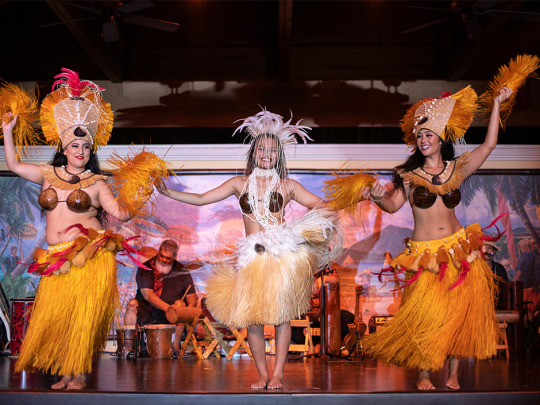
After a long day in the theme parks, coming "home" to Loews Royal Pacific Resort transports you to an exotic South Seas paradise rich with culture. And let me tell you, the true Royal Pacific experience isn't complete without a night at the Wantilan Luau. The Wantilan Luau is an all-you-can-eat- and drink *wink* - dinner show complete with captivating hula and fire dancers that'll leave you enchanted by the stories of the South Seas.
Aloha-Welcome to the Feast
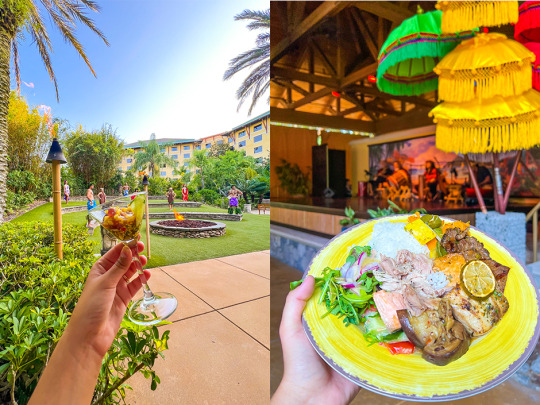
The Wantilan Luau is a feast featuring the treasure flavors of the South Pacific- so pack your loose-fitting Hawaiian shirts and an empty stomach. If you have an "eww pineapple on pizza is gross" kind of person traveling with you, maybe leave them at home. Just kidding.
When you arrive at the luau you'll be seated underneath the Wantilan Pavilion with a view of the resort's lush greenery, stage, fire pit, and of course, the BUFFET. Once seated, you're able to grab your beverages and peruse all of the buffet offerings non-stop through the remainder of the night (and during the show!)
A pro tip from a self-proclaimed all-you-eat-expert: Immediately take a visit to the buffet when you're seated and put a little bit of everything on your plate to start. Do the chit chatty things with your loved ones to get settled WHILE tasting all of the available offerings. THEN, right before the show starts pile up your plate with your favorite Polynesian flavors, sit back, relax and enjoy.
My favorite menu items were the iconic Pit-roasted Suckling Pig, Ahi Pike Salad, Fire-grilled Tender Beef, and Coconut Toasted Jasmine Rice. For dessert, the star was the Passion Fruit Creme Brulee. All of this paired fabulously with the all-you-care-to-enjoy mai tais I sipped on in my souvenir tiki mug (included with premium seating).
The Storytelling Dance of the South Seas

When you watch the dances, chants, and live music, you're not just watching a show void of meaning. You're experiencing fine art with rich history and culture as the performers share a slice of their ancestral knowledge on the stage.
A monologue begins our journey connecting the story of the show to the lore of Loews Royal Pacific Resort. You might be thinking "Lore? you're telling me there's a story behind this resort?" YOU BET THERE IS. In true nerd fashion, if there's a world-building lore I am HERE for it. So, here's some background.
The story starts in the era known as the Gold Age of Travel. Master pilot and adventurer Captain Jake embodied the spirt of the era and carried travelers throughout the Polynesia sharing his love for the traditions and culture of the islands celebrated through the show. According to legend, Jake's plane landed at Loews Royal Pacific Resort (you can spot it floating in the lagoon) and while he has since disappeared, his adventurous spirit remains around the resort. As the show prepares to begin, the narrator encourages you to sit back, relax, and like our beloved Captain Jake, savor the journey through the South Pacific.
While you're adventuring around Royal Pacific on your way to the luau, be sure to visit Jake's American Bar, built in his honor and read the papers and plaques o piece together the details around this tale.
The show travels from the fire pit to the stage, to the audience, and is split into five acts taking you through the Pacific islands of Hawaii, New Zealand, Tonga, Tahiti, and Samoa. As we venture though the five islands, we witness the story come to life through the traditional dances, roaring chants, radiant costumes, pounding of the Nafa Drums, Twirling of the Maori Poi Balls, flaming knives, and of course, audience participation- cue the mai tais.
As cliche as it sounds, the Wantilan Luau really does have something for everyone and very much so fits into my "buffet-style" itinerary for vacation. It's a performance full of beauty and emotion that will keep you entranced the whole way through, while diversifying your Universal vacation in a way you didn't think possible. You'll know it was a good night when you're a little sad that is has to end, but a walk-through Royal Pacific lobby breathing in that iconic Royal Pacific scent makes it all just a little bit better.
The Wantilan Luau is a weekly dinner show taking place most Saturday nights at 6 p.m. at Loews Royal Pacific Resort. The Wantilan Luau is a sperately ticketed event.
Must be 21 years and older with a valid identification to purchse or drink alcholic bevages.
0 notes